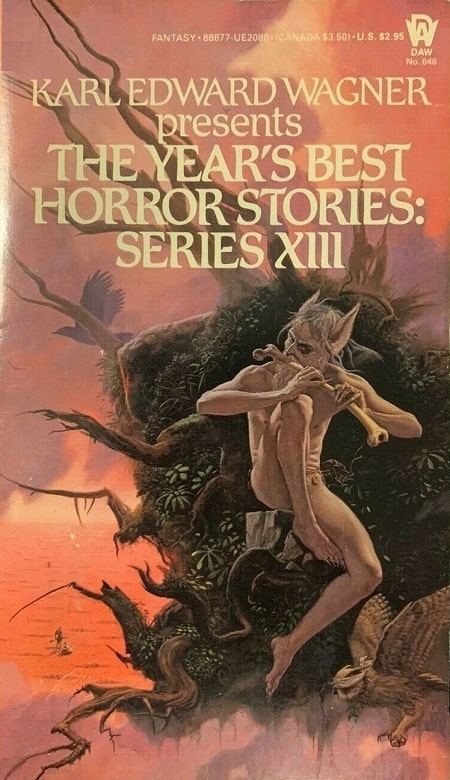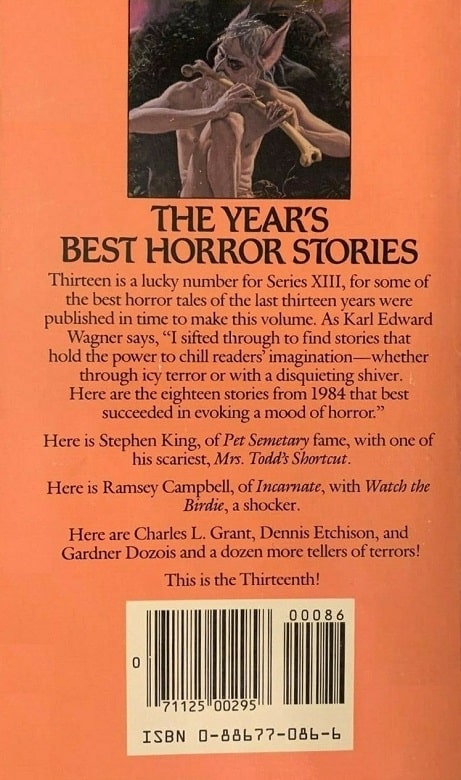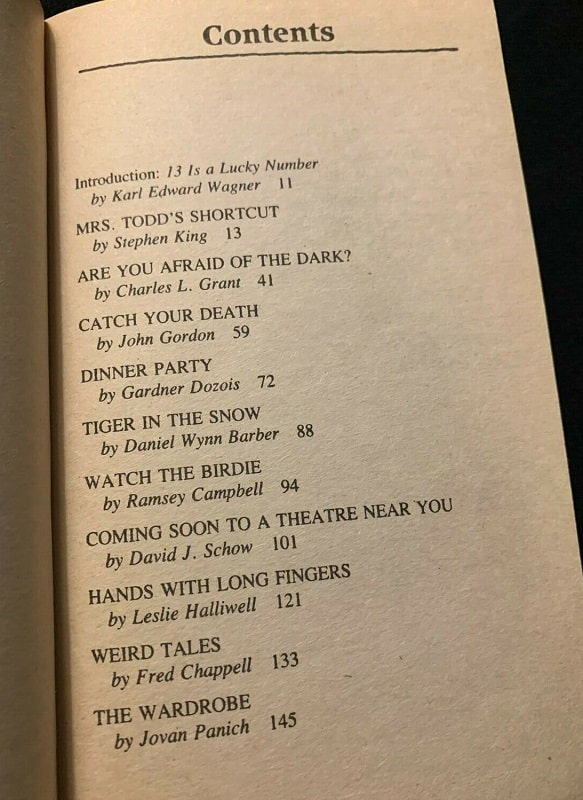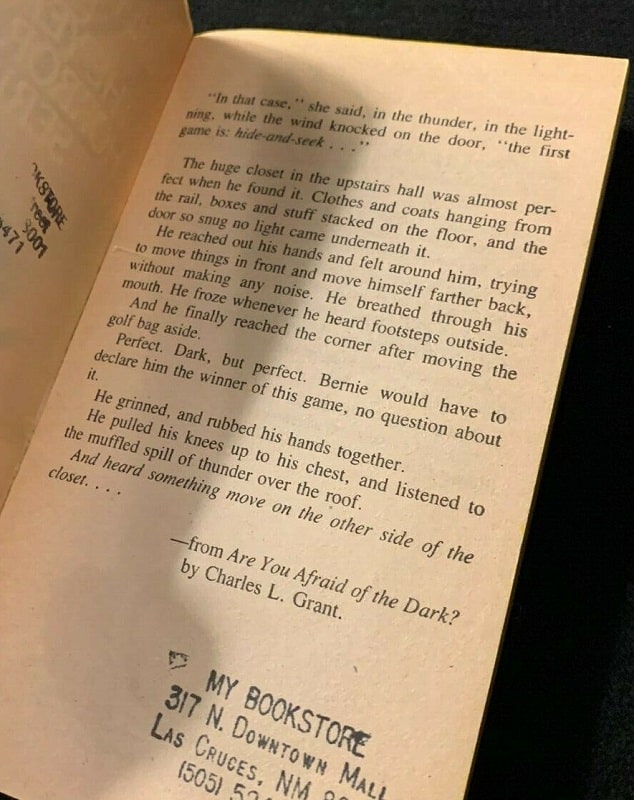Devil Dogs and Haunted Highways: The Year’s Best Horror Stories: Series XIII, edited by Karl Edward Wagner
 |
 |
The Year’s Best Horror Stories: Series XIII (DAW Books, October 1985). Cover by Michael Whelan
The Year’s Best Horror Stories: Series XIII was the thirteenth in the DAW Year’s Best Horror series, and the sixth edited by the great Karl Edward Wagner (1945–1994). The book was copyrighted and printed in 1985. Michael Whelan returns as cover artist after taking a hiatus from Series XII. This marked Whelan’s tenth cover for the series! The newest cover is more fantasy than horror with an elf or goblin-like human playing a bone as a flute in a Pan-like fashion. There is a darkness to the art that is suggestive of horror or darker fantasy. Whelan’s diverse choice of artistic topics for horror does not disappoint.
This volume contained seventeen different authors. All male. Nine were American, six were British, and there is one returning Canadian author, Vincent McHardy and a returning German-born author, David J. Schow. Six of these stories came from books. Another six came from professional magazines. Two came from fanzines, one from a convention program, one from a chapbook, one from a journal, and one from a comic book. Considering the pre-internet era of this volume, Wagner is impressive in that he seemed to read everything from everywhere, looking for good horror.
Table of Contents for The Year’s Best Horror Stories: Series XIII
Wagner’s introduction in Series XIII is much shorter (only two pages) than many of his state-of-the-field type introductions from former volumes. Wagner focuses upon the fact that this is indeed the thirteenth volume — historically and superstitiously a very unlucky number. But Wagner notes that, at least in 1985, not many Year’s Best anthologies had lasted that many years. I don’t know if that’s still true, but it is an admirable accomplishment.
As with previous volumes, Series XIII contains a panoply of excellent stories. But Wagner admits in this introduction something that I had already detected in his previous choices, that his definition of horror was quite broad, and that many of his choices may not fit everyone’s definition of “horror.” As I have stated in other posts, to me good horror should give one a thrill or frisson of fear, an enjoyable yet clearly identifiable feeling of dread. My personal favorite horror stories are cosmic-style horror (e.g., H. P. Lovecraft, T. E. D. Klein, Laird Barron, etc.), but I also enjoy good ghost stories, monster stories, and the occasional psychological thriller. But Wagner seemed to include everything from fantasy to comedy.
For example, in this volume, Stephen King’s “Mrs. Todd’s Shortcut” is really just a fantasy story. King occasionally slips in numinous or somewhat creepy elements but they fail to make the story horrific. I rarely rave about King, but I have to admit that his stories are often so engrossing that thirty-pages in, you forget that you have read that much. “Mrs. Todd’s Shortcut” is an enjoyable and interesting tale, mixing fantasy, mythology, and modern-day automobile travel.
Wagner’s broad definition of “horror” also shows in Fred Chappell’s “Weird Tales,” a somewhat comical yet morbid tale with H. P. Lovecraft, and other real-world personalities, operating as characters. Similarly, David Langford’s “The Thing in the Bedroom” was a straightforward comedy in which the main character is a Carnacki-style occult detective. Not horrific in the least, but the tale is full of chuckle-inducing gems. For example, in the following excerpt the main character shares one of his ingenious methods for solving cases:
As you know, we occult sleuths can deduce a great deal from the answers to innocuous-seeming questions: after some routine inquiries about whether, for example, she regularly celebrated the Black Mass in the room in question, I subtly asked her, “Mrs. Pring, has some terrible tragedy been enacted in that fatal room?” (p. 175)
Nevertheless, Wagner does include some tales that fit squarely within my understanding and tastes in horror. For example, I enjoyed Jovan Panich’s “The Wardrobe” about a haunted or cursed — you guessed it — wardrobe. The story ambiguously ends as a possible psychological horror story though. I also really like John Brizzolara’s “Borderland,” a creepy tale about a night border patrol guarding a stretch of the California and Mexican divide, which seemingly turns out to be haunted.
Roger Johnson’s “The Scarecrow” was also fairly scary. Though the title pretty much gives away the horror. And I also enjoyed “The End of the World” by James B. Hemesath, about a family on a road trip across the Midwest. I tend to find horror stories that involve highway travel to be somewhat scary and Hemesath knocks it out of the park with this one.
Inside cover
One of the best stories in Series XIII, and also a highway travel story, was a tale called “Deadlights” by Charles Wagner (supposedly no relation to Karl Edward Wagner) about a stretch of lonely highway where people are often followed by headlights that are seemingly not attached to any vehicle! Though that premise may sound kind of corny, this was a chillingly effective tale, and fairly disquieting. This volume also included some other good tales by regulars such as Charles L. Grant, Ramsey Campbell and Dennis Etchison.
But in my opinion the best horror story in Series XIII was “Catch Your Death” by John Gordon, which takes place in a small country town somewhere on the British Isles. Two small children (Ron and Sally) keep meeting up with a stray dog that seems vicious, perhaps even demonic, but also seems to like the children. The encounters are ambiguous yet frightening. The story unfolds that their local school teacher, a Miss Mary Birdsall, is wanting to marry a local bachelor, but Birdsall’s elderly mother is selfishly manipulating her and disallowing the relationship to happen. The story ends surprisingly and satisfyingly with an episode of the children attempting to give Miss Birdsall the gift of the black dog in order to cheer her up.
“Miss,” said Sally, and fell silent, suddenly shy.
Ron had to speak. “We thought we’d like to give you something,” he said in a rush, and was going to go on, but the cottage door opened and distracted them.
“Mary! The voice was peevish. “What you doing standing out there with them kids? I been waiting ages.”
“Just a minute, Mother. They want to tell me something.”
“Can’t you see them in the morning? If I stand here any longer I’ll catch me death.” She turned her back and waddled inside.
It was then, with their hands resting on its back, that they felt the dog’s pelt roughen. They glanced quickly down and saw its head lowered as though it was about to charge. They clenched their fingers in its stiff, black hair, half afraid that it would turn on them, but it moved forward and slid easily from their grasp.
They watched it pad through the garden to the open door, push it wider as though it already belonged there, and disappear into the shadows inside. They were listening for a shriek of alarm or anger from the old woman but no sound came, away from the blank doorway.
“You were going to tell me something,” she said, and waited for an answer.
“It was only about the dog,” said Ron.
“What dog?” (pgs. 70–71)
You’ll have to read the rest of it yourself to see what happens to Miss Birdsall’s mother!
Though broad in its definition of horror, The Year’s Best Horror Stories: Series XIII was another excellent addition to Karl Edward Wagner’s continuing series. I recommend it and look forward to the next volume.
Here’s the complete Table of Contents:
Introduction: 13 is a Lucky Number, by Karl Edward Wagner
“Mr. Todd’s Shortcut” by Stephen King (Redbook, May 1984)
“Are you Afraid of the Dark?” by Charles L. Grant (Fantasycon IX Programme Booklet, 1984)
“Catch Your Death” by John Gordon (from Catch Your Death and Other Ghost Stories, 1984)
“Dinner Party” by Gardner Dozois (from For Light Years and Dark, 1984)
“Tiger in the Snow” by Daniel Wynn Barber (The Horror Show, Fall 1984)
“Watch the Birdie” by Ramsey Campbell (from Watch the Birdie 1984)
“Coming Soon to a Theatre Near You” by David J. Schow (Rod Se rling’s Twilight Zone Magazine, Mar./Apr. 1984)
“Hands with Long Fingers” by Leslie Halliwell (from The Ghost of Sherlock Holmes, 1984)
“Weird Tales” by Fred Chappell (The Texas Review, Spring/Summer 1984)
“The Wardrobe” by Lari Davidson (Potboiler Magazine #7, 1984)
“Angst for the Memories” by Vincent McHardy (from Damnations, 1984)
“The Thing in the Bedroom” by David Langford (Knave, Nov. 1984)
“Borderland” by John Brizzolara (Rod Serling’s Twilight Zone Magazine, Nov./Dec. 1984)
“The Scarecrow” by Roger Johnson (Ghost and Scholars #6, 1984)
“The End of the World” by James B. Hemesath (WIND/Literary Journal Vol. 14, No. 51, 1984)
“Never Grow Up” by John Gordon (from Catch Your Death and Other Ghost Stories, 1984)
“Deadlights” by Charles Wagner (Twisted Tales #9, 1984)
“Talking in the Dark” by Dennis Etchison (Shadows 7, 1984)
Previous installments in this series include:
Introduction To DAW Books’ The Year’s Best Horror Stories (1972–1994)
The Year’s Best Horror Stories: Series I (1972)
The Year’s Best Horror Stories: Series II (1974)
The Year’s Best Horror Stories: Series III (1975)
The Year’s Best Horror Stories: Series IV (1976)
The Year’s Best Horror Stories: Series V (1977)
The Year’s Best Horror Stories: Series VI (1978)
The Year’s Best Horror Stories: Series VII (1979)
The Year’s Best Horror Stories: Series VIII (1980)
The Year’s Best Horror Stories: Series IX (1981)
The Year’s Best Horror Stories: Series X (1982)
The Year’s Best Horror Stories: Series XI (1983)
The Year’s Best Horror Stories: Series XII (1984)


Mr. O’Neill, as always, thanks for the opportunity to share on Blackgate.
Really enjoying this series, James. Like Thomas (below), I’ve had a copy of this paperback for over a decade, but it wasn’t until I read your review that I finally made a trip into the basement to fetch it. Thanks for igniting my interest in a forgotten classic!
I’ve had this on my shelf for thirty eight years and have never gotten around to it – but I’m going to take it down this week and read “Deadlights” at least – it sounds damn creepy!
Thomas,
It’s funny — that’s the story that intrigued me too. That and John Brizzolara’s “Borderland.” Something about haunted highways always gets me!
Great! It’s worth reading that one alone. Thanks for the comment!